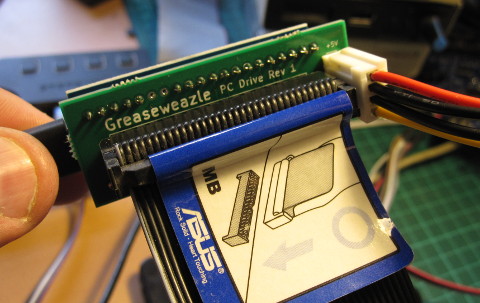Hardware Setup
This is the hardware setup page for F1 and F7 models of Greaseweazle. If you have a V4 device then please read the dedicated setup page.
You should also read the Software Installation page to set up the control software on your host PC, and peruse the Usage pages listed in the wiki sidebar.
Some of the more complex Greaseweazle boards have jumpers which can configure certain actions:
WRITE INHIBIT: Install this jumper to enable writes. You can remove this jumper when preserving disks, to avoid any possibility of accidental writes.
PWR SELECT: On the Lightning Plus a jumper is used to determine whether the board and floppy-power connector are powered from USB or from external 12V supply.
Please see the F7 Plus wiki for instructions on configuring the F7 Plus.
You can connect Greaseweazle to any floppy drive implementing a Shugart interface: Old PC 3.5-inch and 5.25-inch drives are a good choice, or an Amstrad 3-inch drive for Amstrad CPC and Spectrum +3 disks. Note that the drive need not be the same model as in the system to which the disks belong: a Shugart drive is a Shugart drive, and it only really matters that it takes the correct size physical media.

3.5-inch drives typically require only 5v power and can usually be supplied directly from the power header on the Greaseweazle board. Older 5.25- and 3-inch drives typically are more power hungry and require 12v power too: These you must connect to a separate power source, or use a Greaseweazle Plus which accepts an external 12v supply.
If you have problems accessing your drive via a Greaseweazle you believe is correctly set up, it can be because the drive requires more power than it can obtain via USB. In this case try connecting your drive to its own power supply.
The standard floppy bus is open collector with termination (pull-up resistors) at the far receiving end.
The terminations on older 5.25- and 8-inch drives can be as strong as 150 ohms, requiring buffered outputs in the Greaseweazle to successfully drive these signal lines low. These drives will thus only work with buffered models such as F7 Plus and F7 Lightning Plus. It is also important that only one drive in a bussed setup has 150-ohm terminations: Greaseweazle cannot drive into multiple strong pull-ups in parallel.
The strong termination in older drives is usually optional because only the last drive on a ribbon cable is expected to terminate. The terminating resistors on intermediate drives are traditionally either disabled by a jumper, or removed entirely. This correctly terminates the signal lines and also prevents overloading the drive controller's outputs with excessive pull-up current. However, if termination is missing entirely then the drive input signals will float (usually at around 2 volts) with unpredictable results!
- If using 3.5-inch and 3-inch drives, this is not a concern. Their terminations are weaker and cannot be disabled.
- If using a 5.25- or 8-inch drive on its own, make sure that the termination resistors are present and enabled.
- If using a 5.25- or 8-inch drive in a multi-drive setup, you probably do not need the termination resistors.
Note that an unterminated setup will work with other flux boards such as Kryoflux and Supercard Pro, which actively drive their outputs both high and low. Greaseweazle by contrast has standard open-collector outputs which rely on termination resistors to pull signals high.
Connect to your host PC (Linux, Mac, Windows, etc) using a normal USB cable. Greaseweazle appears as a serial or modem device, depending on your OS.